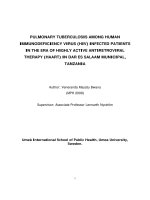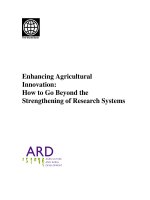Greece beyond the horizon of the era of transition archimedean screw hydropower development terra incognita
Bạn đang xem bản rút gọn của tài liệu. Xem và tải ngay bản đầy đủ của tài liệu tại đây (1.03 MB, 10 trang )
INTERNATIONAL JOURNAL OF
ENERGY AND ENVIRONMENT
Volume 6, Issue 6, 2015 pp.527-536
Journal homepage: www.IJEE.IEEFoundation.org
Greece beyond the horizon of the era of transition:
Archimedean screw hydropower development terra
incognita
Alkistis Stergiopoulou1,2, Vassilios Stergiopoulos3, Efrossini Kalkani1
1
National Technical University of Athens, Department of Water Resources and Environmental
Engineering, School of Civil Engineering, 15780 Athens, Greece.
2
University of Natural Resources and Life Sciences, Institute for Water Management, Hydrology and
Hydraulic Engineering, Muthgasse 18, A-1190 Vienna, Austria.
3
School of Pedagogical and Technological Education, Department of Civil Engineering Educators,
ASPETE Campus, Eirini Station, N.Heraklio, 14121 Athens, Greece.
Abstract
The main aim of this paper is to prove, according to our inventory that, beyond the horizon of the era of
transition and economic crisis of nowadays, Greece is a real “Archimedean Screw Hydropower
Development Terra Incognita”, a country generously blessed with water, having an important
hydropower potential. This inventory shows that the unexploited small hydropower capacity of Greece,
including Archimedean possibilities, is approximately 3.500MW. The significant untapped small
hydrodynamic potential demonstrates the important role of Pindos Mountain Range, controlling the
annual rainfall difference between the North-Western and the Eastern Greece. The climatic and
topographic conditions in Greece favor the development of many small Archimedean screw hydropower
stations, harnessing the potential of a large number of small and big watercourses crossing mainland of
the country. Pleiades of very promising Archimedean small hydro screw plants, having inclined and
horizontal axis hydrodynamic rotors, could be installed following two hydro development axis (spears).
Copyright © 2015 International Energy and Environment Foundation - All rights reserved.
Keywords: Renewable energy; Small hydro; Archimedean screw turbines; Energy systems.
1. Introduction
During the last years of the strong economic crisis, the recession has been damaging the long-term
productivity of whole Greek economy, leading to lower investments including white gold and creating
strong discussions with controversies and different views concerning small hydro. Although the small
hydro perspective is of considerable interest and the hydropower fuel is the largest, the most viable and
reliable future indigenous renewable source of energy, the current status of many Greek decision makers’
attitudes are characterized by erroneous opinions and obsessions. Despite the existing very promising
potential, the installed capacity of small hydro power plants is only a few hundreds MW representing
about 10% of the currently installed capacity from renewable energy sources and producing
approximately 18% of the Renewable Energy Source (R.E.S.) produced energy. The present paper
proves that the climatic and topographic conditions in Greece favor the development of many small
hydropower stations, harnessing the potential of a large number of rivers crossing mainland of the
ISSN 2076-2895 (Print), ISSN 2076-2909 (Online) ©2015 International Energy & Environment Foundation. All rights reserved.
528
International Journal of Energy and Environment (IJEE), Volume 6, Issue 6, 2015, pp.527-536
country and ending up in the Aegean Archipelago. A recent inventory will show that the existing
unexploited theoretical small hydropower capacity of Greece, including Archimedean possibilities, is
very important about some thousands of MW, with an important total theoretical hydropotential in TWh.
These preliminary hydropotential results demonstrate the important role of Pindos Mountain Range and
the predominance of the water districts of Epirus and of Macedonia, having together the most important
theoretical hydropotential of the whole country. Despite the fact that there are thousands of very
promising potential sites at small waterfalls and many river weirs across the country, low head
hydropower is developing very slowly in Greece. Archimedean screws are a new type of turbines, not
only in Greece but also in all countries throughout the world, giving nowadays very promising
perspectives for a real green screw small hydropower development [1-4].
2. A short view of recent a.s.t. research for A.I.A.H.T. & A.W.C.T.
Various innovative small-scale models of new Archimedean Screw Turbines (A.S.T.’s) were designed,
and developed in the framework of the research program of ARCHIMEDES III. During the last years a
series of extensive ARCHIMEDES III research experiences had been made in an open flume hydraulic
experimental channel, concerning initially various, small-scale AIAHT’s (Archimedean Inclined Axis
Hydropower Turbines) configurations. Two representative Archimedean experiences in an open flume
channel for two inclined axis AST are schematically illustrated in Figure 1, together with the first
experimental results (efficiency η in function of flow ratio Q/Qo, with Qo the design flow) relative to a
third AIAHT closed circuit integrated hydropower plant [4-8].
Figure 1. Three innovative small-scale models Archimedean spiral rotors developed in the framework of
the research program ARCHIMEDES III (photos A. Stergiopoulou)
ISSN 2076-2895 (Print), ISSN 2076-2909 (Online) ©2015 International Energy & Environment Foundation. All rights reserved.
International Journal of Energy and Environment (IJEE), Volume 6, Issue 6, 2015, pp.527-536
529
Recently three other new 2-bladed AIAHT, of the same length 30.5cm, the same input diameter 5cm,
with an output diameter 9.4cm and three step ratio S/D=1, 0.8 and 1.2, were developed and are under
experimental exloitation in the framework of the same research program (Figure 2) [4-8].
Figure 2. New AIAHT’s representative ARCHIMEDES III experiences (photos A. Stergiopoulou)
The possibility of exploiting kinetic hydraulic energy of irrigation and drainage hydraulic networks, and
currents of technical and natural watercourses, for power generation, have both been given little
attention, although such currents represent a large renewable energy resource which could be exploited
by “modern Archimedean screw technologies”. A series of Archimedean Water Current Turbines
(AWCT) photorealistic views, with horizontal axis floating screws for the Greek natural and irrigation
man-made networks are presented in Figure 3. In this figure are given the geometrical characteristics of
the new horizontal Archimedean Screw Turbine recently installed and experimented in the hydraulic
channel of the Laboratory of the Institute for Water Management, Hydrology and Hydraulic Engineering,
in Vienna with the dimensions Lchannel=10m, bchannel=1.4m, h channel(depth)=1m. Some photorealistic views
of floating AWCT’s are given in the same figure [9].
Figure 3. Design of a new developed horizontal screw rotor with photorealistic views of floating screws
(photos A. Stergiopoulou)
ISSN 2076-2895 (Print), ISSN 2076-2909 (Online) ©2015 International Energy & Environment Foundation. All rights reserved.
530
International Journal of Energy and Environment (IJEE), Volume 6, Issue 6, 2015, pp.527-536
3. Towards a Greek Archimedean small hydropotential inventory
The important role, mainly of Pindos Mountain Range, controlling the annual rainfall difference between
the North-Western and the Eastern Greece seems to become obvious in Figure 4.
A general idea concerning the map of the annual isoyetial curves of Greece in mm is given in Figure 5.
Figure 4. The presence of Pindos Mountain Range controlling the climatometeorological conditions of
Greece
Figure 5. Map of the isoyetial curves of Greece, in mm (1950-2000)
An area of about 45.915 km2, corresponding to 35% of total Greek surface 131.913 km2, was
investigated by using simple quasi-linear formulas, water discharge values and data determined by
precipitation and evapotranspiration in order to obtain a first theoretical hydropower potential estimation
of each Greek watershed, each water basin and district, as a function of mean flow and gross head for the
14 Greek water districts. The theoretical Archimedean hydropower potential is calculated by using the
linear formula, Ei, th (KWh) = 9.81×(Qi×∆Hi) × 8,760, with Qi(m3/s), as the representative from the flow
duration curve water discharge and ∆Hi (m), as the available constant over the year head in watercourse.
Figure 6 gives the percentages of the 14 Greek Water Districts investigated areas and the theoretical
Archimedean hydropotential, in GWh.
ISSN 2076-2895 (Print), ISSN 2076-2909 (Online) ©2015 International Energy & Environment Foundation. All rights reserved.
International Journal of Energy and Environment (IJEE), Volume 6, Issue 6, 2015, pp.527-536
531
Figure 6. Percentages of the 14 Greek Water Districts investigated areas and the theoretical Archimedean
hydropotential, in GWh
The theoretical specific Archimedean small hydrocapacity (KW/Km²) had been calculated easily in the
basis of the obtained energy output. A mean value of 74.7 (KW/Km²) corresponds to the total
investigated area. The small hydropower density or rather the specific theoretical small hydropotential of
the entire country, is approximately calculated 0.651 GWh/Km². Such preliminary Archimedean small
hydropotential results demonstrate the predominance of the water districts of Epirus and of Macedonia,
having together the most important theoretical hydropotential of the whole country. The same could be
said for their theoretical small hydropotential (20TWh, 1500MW) and the corresponding specific
theoretical hydropotential (2 GWh/Km², 250 KW/Km²). The important role, mainly of the Pindos
Mountain Range, controlling the annual rainfall difference between the North-Western Greece (1.000 to
2.000mm) and the Eastern Greece (400 to 500 mm/year) seems to be obvious. It is important to note, for
the Epirus water district that, even though its total area is only 7.55% of the total Greek area, the
corresponding Archimedean hydropotential is greater than 38% of the total calculated small Greek
hydropotential. The corresponding theoretical Archimedean small hydropotential is 11.48TWh,
1310.6MW. The specific theoretical hydropotential is 2.25GWh/Km² and 257KW/Km². The small
hydroelectric potential role of Pindos mountain range and a series of other mounts (e.g. the Vermion,
Olympos, Athos, Taygetos etc.) is obvious. The total theoretical Archimedean hydropower potential of
the natural watercourses obtained for the estimated Greek area is around E th = 30 TWh. The present
calculations correspond to an overall theoretical Archimedean small hydrocapacity of about 3,500 MW.
In this inventory is not included the important small hydropower kinetic energy potential of natural
watercourses, water supply and irrigation systems neither the very promising coastal and tidal currents
potential. Following the Archimedean small hydropotential inventory the corresponding total Greek
energy conservation, in terms of T.O.E. and T.C.E., is estimated more than 2.57.10 6 T.O.E. and
5.14.10 6 T.C.E. respectively. According to this inventory, it seems that Greece has, in the Era of
Transition and in the economic crisis of nowadays, an important unexploited Archimedean hydropower
potential of several TWh and an Archimedean hydrocapacity of thousands of MW. Despite the fact that
there are thousands of very promising potential sites at small waterfalls and many river weirs of Greece,
low head hydropower is developing very slowly across the country.
4. Towards a “double spears Archimedean hydropower development”
According to the under evolution research, within ARCHIMEDES III program, the cochlear screws
could find very promising modern applications, as efficient hydraulic turbomachines [7-9]. Pleiades of
promising small hydro sites in Greece are presented in Figure 7, in which is also given a “2 Hydro Spears
Macedonian Phalanx” representation, with the important small hydroelectric role of Pindos mountain
range, along the first Archimedean spear, from Epirus, Thessaly, Central Greece, Peloponnesus, and the
role of the mounts of Vermion, Veras, Paikon, Rodope of Northern Greece, Macedonia and Thrace,
along the second Archimedean spear. It is important to note that the two spears Macedonian Hydro
Phalanx characterize the hydropower development of Greece, including the first hydropower stations
ISSN 2076-2895 (Print), ISSN 2076-2909 (Online) ©2015 International Energy & Environment Foundation. All rights reserved.
532
International Journal of Energy and Environment (IJEE), Volume 6, Issue 6, 2015, pp.527-536
being in operation since 1954 in Agras, Louros, Ladon and the larger hydropower stations in Central
Macedonia, in Thrace, in Thessaly and in West Central Greece.
Figure 7. The two Hydro Spears of Greece
The very significant untapped small hydrodynamic potential, of about 30 TWh, according to the present
inventory, the current Greek economic crisis situation and all systematic efforts relative to the small
hydrodynamic behaviour studies of innovative low and zero head Archimedean screw turbines could
give an increased impetus in low head hydraulic renewable energy sources.
The two long hydropower spears of this Macedonian development phalanx could be a real offensive
Archimedean hydropower development tactic formation of Greece against the present crisis and a source
of future hydro-economic prosperity as the glorious hydro-prosperity of the recent past (Figure 8). Figure
8 gives also a schematic representation of one Archimedean Screw Turbine with inclined shaft exploiting
the potential of a watercourse having a flow discharge Q and a height H.
Figure 8. The “2 Hydro Spears Macedonian Phalanx Archimedean Hydro Development” of Greece
For such a Greek Archimedean small hydropower development effort, mainly along the “North-South
Small Hydropower Development Spear”, series of questions to be answered are real technical dilemmas.
These dilemmas are illustrated in Figure 9. First dilemma: what are more efficient, Archimedean screws
in series or in parallel? Second dilemma: if we have a site with screw in series how many screws should
be connected? Third dilemma: if we have a site with screws in parallel how many screws should be
connected? Fourth dilemma: if we have a site with the combined solution of screws in parallel and
ISSN 2076-2895 (Print), ISSN 2076-2909 (Online) ©2015 International Energy & Environment Foundation. All rights reserved.
International Journal of Energy and Environment (IJEE), Volume 6, Issue 6, 2015, pp.527-536
533
screws in series how many screws should be connected for each case? The Fifth Archimedean screw
dilemma concerns all the various environmental sensible regions (e.g. Holy Mount of Olympus, Mount
of Athos, Samothrace Island etc.) (Figure 9).
Figure 9. First, second, third, fourth and fifth Archimedean hydropower development dilemmas (photos
A. Stergiopoulou)
For a particular Archimedean Screw Turbine case study, concerning a first site, in the Drainage Channel
66 (Figure 10), in Imathia Prefecture, the maximum flow of the screw turbine is estimated to be 4.67
m3/s. The net head is calculated by estimating the hydraulic losses or after assumption of 3% head losses.
The gross head was 1.50m. Then the net head becomes 1.45m. The generated power on the turbine axis
is Pt=49.821 KW (with ηturb=0.75) and the generated electrical power is P=41.501 KW (with ηgen=0.98
and ηgear=0.85). It is estimated that the AST would be operated at the maximum power of 41.501KW
with a design flow approximately at least 4.67 m3/s in the river for 150 days per year. For the rest of the
year the turbine would be operated with reduced power. The annual energy production is estimated on
the basis of the capacity factor CF = time of design operation/8760. In our case, CF is around 0.65. The
annual energy production E(KWh)=P(KW).CF.8760 is calculated E(KWh)=236 307 KWh/year. A first
estimation of the installation cost gives a total amount of 121 000 E, with 58 000E for the equipment of
AST, turbine and generator, 40 000E for the civil works, 15 000E the electrical system and the
connections, 8 000E other. A quick first economical analysis would probably give a very interesting P.P.
(payback period) of 5-6 years, a very good N.P.V. (Net Present Value) and an efficient I.R.R. (Internal
Rate of Return). In general AST power development in this particular site is good idea for investment in
Archimedean green energy.
Figure 10. A general view of a first site of the drainage channel 66 for a possible AST future
development (photos A. Stergiopoulou)
ISSN 2076-2895 (Print), ISSN 2076-2909 (Online) ©2015 International Energy & Environment Foundation. All rights reserved.
534
International Journal of Energy and Environment (IJEE), Volume 6, Issue 6, 2015, pp.527-536
For a second site, in the Tripotamos river catchment area, near the town of Veria, for a future
Archimedean Small Hydro exploitation, with H=2.34m and the flow variation curve (Q(m3/s), t=days)
illustrated in Figure 11, the river F.D.C curve and the useful F.D.C. curve in common with a preliminary
study propose a final Archimedean plant, with nominal flow 2 m3/s, efficiency of the screw turbine
84.75 %, efficiency of the generator 93 (%), efficiency of the multiplicator 91.2(%), installed power
P=33 KW, and energy produced per year Ε=107 976,8 ΚWh.
Figure 11. A site for an Archimedean Small Hydro exploitation with F.D.C curves
For a third site, in the Arapitsa River catchments area, near a small irrigation weir, downstream of the
town of Naoussa, a potential future Archimedean Small Hydro exploitation for H=4.68 m and the same
flow data, should be based probably on 2 similar screw turbines in series (Figure 12). The total installed
power P = 2 x 33 = 66 KW and a yearly produced energy Ε= 2 x 107 976,8 =215 953,16ΚWh.
Figure 12. Typical schemes with two AST’s, in series, in one irrigation weir in Arapitsa
(photos A. Stergiopoulou)
For a fourth site, in the drainage channel 66, with a head of 2.34m and a design flow 4m3/s, it is possible
to install in parallel two similar screw turbines, having an individual hydrocapacity of 33KW and a
yearly productivity of 107 976, 8 ΚWh giving a total install capacity of 66 KW and a total yearly energy
production of 215 953,16ΚWh.
5. Conclusions
Beyond Pindos mountain range a series of other mounts play a supplementary role with Pindos range
along the first Archimedean development spear from Epirus to Thessaly and Peloponnesus. According to
the present research a Pleiades of promising small hydro plants could be developed in Greece along a
ISSN 2076-2895 (Print), ISSN 2076-2909 (Online) ©2015 International Energy & Environment Foundation. All rights reserved.
International Journal of Energy and Environment (IJEE), Volume 6, Issue 6, 2015, pp.527-536
535
first North-South hydropower development spear. Another big series of hydropower plants could be
installed in the sites along a second hydro development West-East spear, on the basis of the mounts
Vermion, Voras, Rodope of Northern Greece, Macedonia and Thrace. The final goal of this paper was to
give an affirmative answer to the following question: “Can growth and development come back in
Greece?” This can be indeed achieved by following the proposed here two Spears of Small Hydropower
Development & Growth Phalanx harnessing the unexploited and very promising potential. This Small
Hydropower Development & Growth Phalanx with several hundreds of Archimedean small hydropower
plants, including the Archimedean schemes, in series and parallel exploiting the climatic, topographic
and hydraulic conditions of the two spears of Greece could be a real offensive hydropower development
tactic formation of Greece against the present crisis, able to return from the past the lost and forgotten
hydropower prosperity. According to the presented here, very promising and unexploited small
hydropower potential, inventory of the whole country, Greece seems to be, beyond the horizon of the Era
of Transition, and in the economic crisis of nowadays, a real “Archimedean Screw Hydropower
Development Terra Incognita”. The included innovative Archimedean hydropower schemes, in cascade
and in parallel, for a series of low-head sites and for a series of horizontal floating screws, exploiting the
kinetic energy of rivers, open channels, tidal and sea currents, are good examples for further efficient soft
and green development and exploitation of the “Hellenic Archimedean Small Hydro Terra Incognita”.
Acknowledgements
This research has been co-financed by the European Union (European Social Fund – ESF) and Greek
national funds through the Operational Program "Education and Lifelong Learning" of the National
Strategic Reference Framework (NSRF) - Research Funding Program ARCHIMEDES III (Investing in
knowledge society through the European Social Fund) as part of the research project “Rebirth of
Archimedes: Contribution to the study of hydraulic mechanics and hydrodynamic behaviour of
Archimedean cochlear waterwheels, for recovering the hydraulic potential of natural and technical
watercourses, of maritime and tidal currents”.
References
[1] Rorres, C., (2000) ‘The Turn of the Screw: Optimal Design of an Archimedes Screw’, Journal of
Hydraulic Engineering.
[2] Kantert, P.J., (2008) “Praxishandbuch Schneckenpumpe“, Hirthammer Verlag 2008, ISBN 978-388721-202-5.
[3] Pelikan, B., Lashofer, A., “Verbesserung der Strömungseigenschaften sowie Planungs-und
Betriebsoptimierung von Wasserkraftschnecken Research Project, BOKU University, Vienna, (in
German), 2012.
[4] Stergiopoulou, A. and Stergiopoulos, V. (2009) ‘From the old Archimedean Screw Pumps to the
new Archimedean Screw Turbines for Hydropower Production in Greece’, Proceedings of the 2nd
International Conference on Environmental Management, Engineering, Planning & Economics
(CEMEPE 2009), Mykonos.
[5] Stergiopoulou, A., Stergiopoulos, V. and Κalkani, E., “A brief Archimedean history: from ancient
spiral screws to modern Archimedean hydropower energy tools”, Proceedings of the eRA-5
International Conference , Athens, 2010.
[6] Stergiopoulou, A. and Stergiopoulos, V., ‘The paradox of coastal cross flow in Cephalonia island’,
Proceedings of the 6th International Symposium on Environmental Hydraulics, Athens, 2010.
[7] Stergiopoulou, A., Stergiopoulos, V. and Κalkani, E., ‘Back to the Future: Rediscovering the
Archimedean Screws as Modern Turbines for Harnessing Greek Small Hydropower Potential’,
Proceedings of the “Third International Conference on Environmental Management, Engineering,
Planning and Economics (CEMEPE 2011) & SECOTOX Conference”, Skiathos, 2011.
[8] Stergiopoulou, A. and Kalkani, E. (2012) ‘Investigation of the hydrodynamic behaviour of
innovative cochlear turbines’, (accepted) 12th EYE and 8th EEDYP Conference, 2012.
[9] Stergiopoulou, A., Stergiopoulos, V., Kalkani, E., “Experimental and Theoretical Research of Zero
Head Innovative Horizontal Axis Archimedean Screw Turbines”, (to be published in the IJEE),
2015.
ISSN 2076-2895 (Print), ISSN 2076-2909 (Online) ©2015 International Energy & Environment Foundation. All rights reserved.
536
International Journal of Energy and Environment (IJEE), Volume 6, Issue 6, 2015, pp.527-536
Alkistis Stergiopoulou is Ph.D. Candidate of the National Technical University of Athens, Master of
Science in Water Resourses & Technology (Civil Engineering School, National Technical University of
Athens, 2008), Master in Total Quality Management (Open University of Greece, 2012), BSc in Natural
Resources Management & Engineering (Agricultural University of Athens, 2007). She is Research
Associate in BOKU University of Natural Resources and Life Sciences (Vienna, Austria, 2014-2015)
and Basic Scientific Member of the National Research Project ARCHIMEDES III. Her main research
interests are, Archimedean Screw Turbines, Small Hydropower, Renewable Energy Sources, C.F.D.,
Applied Hydraulics and Fluid Mechanics.
E-mail adress:
Vassilios Stergiopoulos is Professor of Hydraulics and Hydropower at the Civil Engineering Educators
Department of the School of Pedagogical and Technological Education (ASPETE, Athens, Greece),
Docteur d’Etat ès Sciences Mathématiques (University of Aix-Marseille II, France) Docteur-Ingenieur
and D.E.A. in Fluid Mechanics (University of Aix-Marseille). His main research interest are
Archimedean Screw Turbines and Plants, Small Hydropower and Hydraulic Turbomachines,
Renewable Energy Sources, Environmental Hydraulics and Fluid Mechanics, C.F.D.
E-mail adress: ,
Efrossini Kalkani is Professor Emeritus of the N.T.U.A. (National Technical University of Athen
Professor of Hydropower and Hydropower at the Civil Engineering School of the N.T.U.A. Her ma
research interests are, Renewable Energy Sources, Hydropower and Energy Production, Archimede
Screw Turbines, Applied Hydraulics, New and Green Technologies.
E-mail adress:
ISSN 2076-2895 (Print), ISSN 2076-2909 (Online) ©2015 International Energy & Environment Foundation. All rights reserved.









